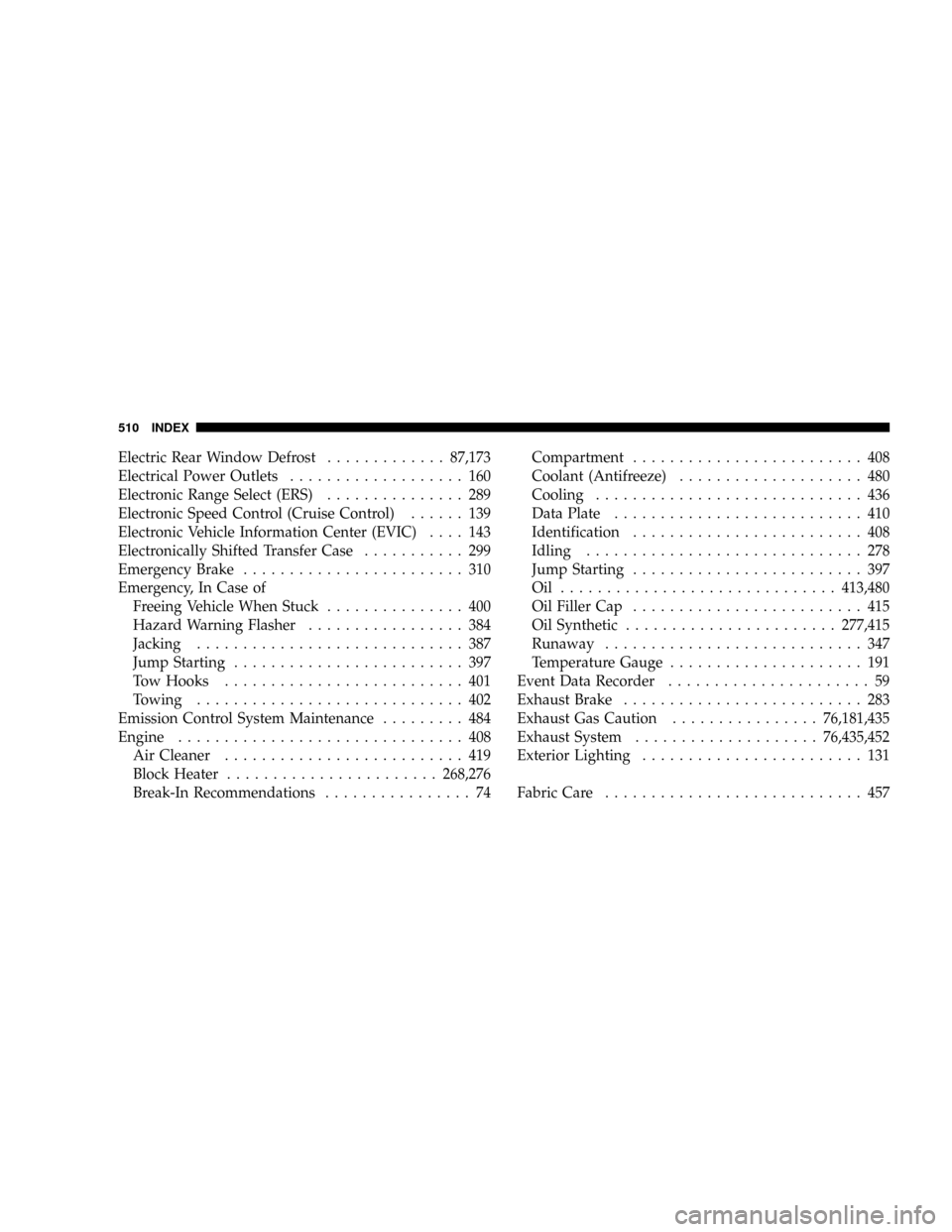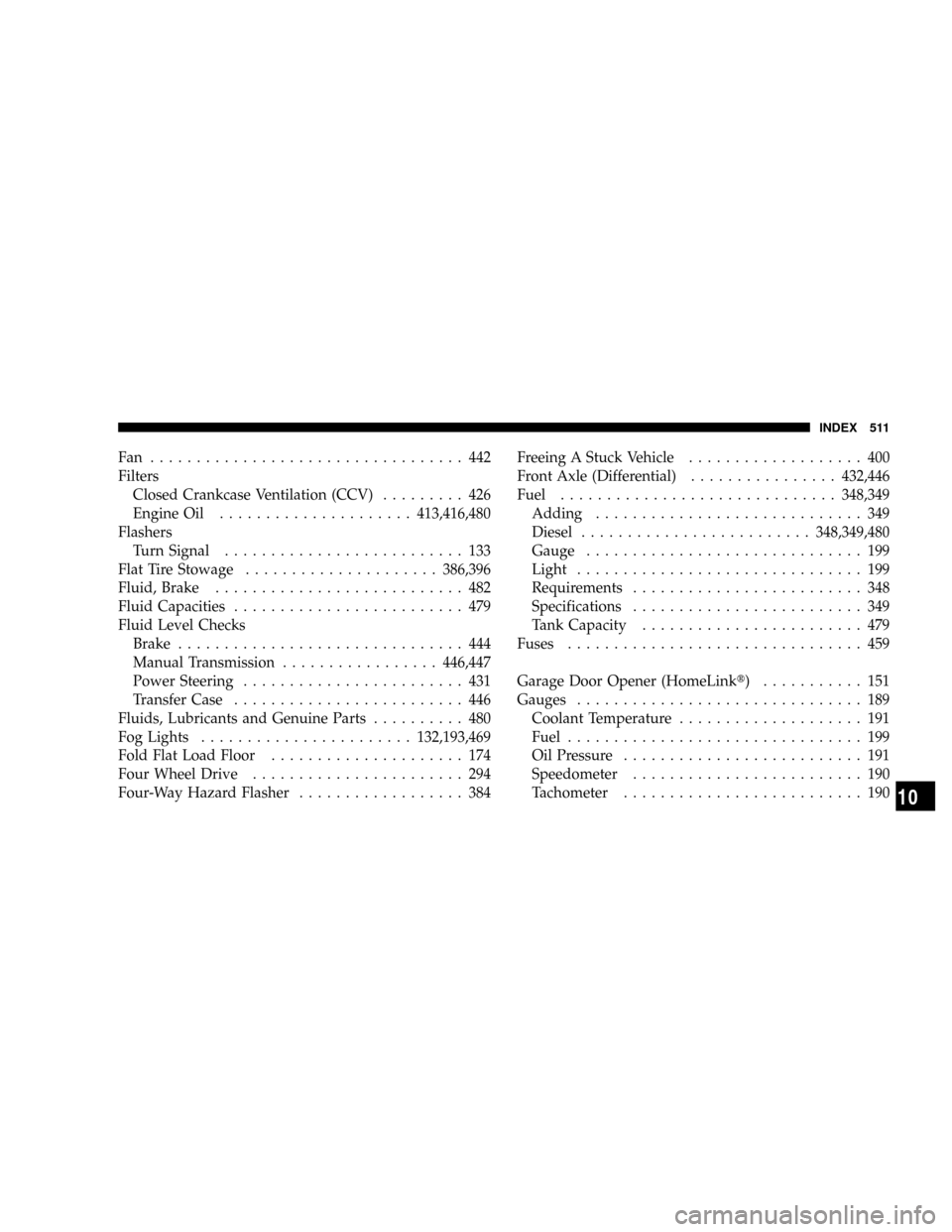2008 DODGE RAM 2500 DIESEL coolant temperature
[x] Cancel search: coolant temperaturePage 438 of 527

Cooling System
WARNING!
You or others can be badly burned by hot coolant or
steam from your radiator. If you see or hear steam
coming from under the hood, don't open the hood
until the radiator has had time to cool. Never try to
open a cooling system pressure cap when the radiator
is hot.
Engine Coolant Checks
Check the engine coolant (antifreeze) protection every 12
months (before the onset of freezing weather, where
applicable). If coolant is dirty or rusty in appearance, the
system should be drained, flushed and refilled with fresh
coolant. Check the front of the A/C condenser for anyaccumulation of bugs, leaves, etc. If dirty, clean by gently
spraying water from a garden hose vertically down the
face of the condenser.
Check the coolant recovery bottle tubing for brittle rub-
ber, cracking, tears, cuts and tightness of the connection
at the bottle and radiator. Inspect the entire system for
leaks.
Extremely cold ambient temperatures may require the
addition of a ªwinter frontº for effective operation of the
cab heating/cooling system. Make certain that a percent-
age of the radiator is exposed for adequate air flow
through the charge air cooler and automatic transmission
oil cooler. The percentage of opening must be increased
with the increasing ambient air temperature and/or
engine load. If the cooling fan can be heard cycling
frequently, increase the size of the opening in the winter
front.
436 MAINTAINING YOUR VEHICLE
Page 439 of 527

Coolant bottle level check
The coolant reserve system provides a quick visual
method of determining that the coolant level is adequate.
With the engine idling and warmed to the normal
operating temperature, the level of the coolant on the
coolant bottle should be between the fluid level marks.
Check the coolant level whenever the hood is raised.
The radiator normally remains completely full, so there is
no longer a need to remove the coolant pressure cap
except for checking coolant freeze point or replacement
with new antifreeze coolant.WARNING!
Never add coolant to the radiator when the engine is
overheated. Do not loosen or remove pressure cap to
cool overheated engine! The coolant is under pres-
sure and severe scalding could result.
Cooling System Ð Drain, Flush and Refill
At the intervals shown on the Maintenance Schedules,
the system should be drained, flushed and refilled. See
you authorized dealer for service.
MAINTAINING YOUR VEHICLE 437
7
Page 441 of 527

Adding Coolant
Your vehicle has been built with an improved engine
coolant that allows extended maintenance intervals. This
coolant can be used up to 5 Years or 100,000 miles (160
000 km) before replacement. To prevent reducing this
extended maintenance period, it is important that you
use the same coolant throughout the life of your vehicle.
Please review these recommendations for using Hybrid
Organic Additive Technology (HOAT) coolant. When
adding coolant:
²The manufacturer recommends using Mopart
Antifreeze/Coolant 5 Year/100,000 Mile Formula
HOAT (Hybrid Organic Additive Technology).
²Mix a minimum solution of 50% HOAT engine coolant
and distilled water. Use higher concentrations (not to
exceed 70%) if temperatures below -34ÉF (-37ÉC) are
anticipated.
²Use only high purity water such as distilled or deion-
ized water when mixing the water/engine coolant
solution. The use of lower quality water will reduce
the amount of corrosion protection in the engine
cooling system.
Please note that it is the owner's responsibility to main-
tain the proper level of protection against freezing ac-
cording to the temperatures occurring in the area where
the vehicle is operated.
NOTE:Mixing coolant types will decrease the life of the
engine coolant and will require more frequent coolant
changes.
Cooling System Pressure Cap
The cap must be fully tightened to prevent loss of coolant
and to ensure that coolant will return to the radiator from
the coolant recovery bottle.
MAINTAINING YOUR VEHICLE 439
7
Page 443 of 527

The radiator normally remains completely full, so there is
no need to remove the radiator cap unless checking for
coolant freeze point or replacing coolant. Advise your
service attendant of this. As long as the engine operating
temperature is satisfactory, the coolant bottle need only
be checked once a month.
When additional coolant is needed to maintain the
proper level, it should be added to the coolant bottle. Do
not overfill.
Points To Remember
NOTE:When the vehicle is stopped after a few miles (a
few kilometers) of operation, you may observe vapor
coming from the front of the engine compartment. This is
normally a result of moisture from rain, snow, or high
humidity accumulating on the radiator and being vapor-
ized when the thermostat opens, allowing hot coolant to
enter the radiator.If an examination of your engine compartment shows no
evidence of radiator or hose leaks, the vehicle may be
safely driven. The vapor will soon dissipate.
²Do not overfill the coolant recovery bottle.
²Check coolant freeze point in the radiator and in the
coolant recovery bottle. If antifreeze needs to be
added, contents of coolant recovery bottle must also be
protected against freezing.
²If frequent coolant additions are required, or if the
level in the coolant recovery bottle does not drop when
the engine cools, the cooling system should be pres-
sure tested for leaks.
²Maintain coolant concentration at 50% HOAT engine
coolant (minimum) and distilled water for proper
corrosion protection of your engine which contains
aluminum components.
MAINTAINING YOUR VEHICLE 441
7
Page 444 of 527

²Make sure that the radiator and coolant recovery
bottle overflow hoses are not kinked or obstructed.
²Keep the front of the radiator clean. If your vehicle is
equipped with air conditioning, keep the front of the
condenser clean also.
²Do not change the thermostat for summer or winter
operation. If replacement is ever necessary, install
ONLY the correct type thermostat. Other designs may
result in unsatisfactory coolant performance, poor gas
mileage, and increased emissions.
Fan
Inspection
Check the fan for cracks and bent or broken blades. If any
of these conditions exist, you must replace the fan. Make
sure it is securely mounted.NOTE:This service procedure must be performed by a
trained service technician. Make arrangements with your
authorized dealer for this inspection.
Charge Air Cooler (Inter-Cooler)
The charge air cooler is positioned between the radiator
and the air conditioner condenser. Air enters the engine
through the air cleaner and passes through the turbo-
charger where it is pressurized. This pressurized air
rapidly reaches high temperature. The air is then directed
through a hose to the charge air cooler and through
another hose to the intake manifold of the engine. The air
entering the engine has been cooled by about 50 to 100
degrees Fahrenheit. This cooling process enables more
efficient burning of fuel resulting in fewer emissions.
442 MAINTAINING YOUR VEHICLE
Page 511 of 527

Drain, Flush, and Refill.................. 437
Inspection........................... 440
Points to Remember.................... 441
Pressure Cap......................... 439
Radiator Cap......................... 439
Selection of Coolant (Antifreeze).........438,480
Temperature Gauge..................... 191
Cruise Control (Speed Control).............. 139
Cup Holder............................ 163
Customer Assistance..................... 497
Data Recorder, Event...................... 59
Daytime Running Lights................... 132
Dealer Service.......................... 410
Defroster, Rear Window.................87,173
Defroster, Windshield................77,251,253
Delay (Intermittent) Wipers................. 136
Diesel Exhaust Brake..................... 283
Diesel Fuel............................ 348Diesel Fuel Requirements.................. 348
Differential, Limited-Slip.................. 306
Dipsticks.............................. 413
Power Steering........................ 431
Disc Brakes............................ 443
Disposal.............................. 418
Engine Oil........................... 418
Used Coolant (Antifreeze)................ 440
Door Locks............................. 26
Door Locks, Automatic.................... 146
Door Opener, Garage..................... 151
Draining Fuel/Water Separator Filter.......... 422
Drive Belts............................ 418
Driving
Through Flowing, Rising, or Shallow Standing
Water.............................. 307
Dual Rear Wheels.....................337,394
DVD Player (Video Entertainment System)...... 241
INDEX 509
10
Page 512 of 527

Electric Rear Window Defrost.............87,173
Electrical Power Outlets................... 160
Electronic Range Select (ERS)............... 289
Electronic Speed Control (Cruise Control)...... 139
Electronic Vehicle Information Center (EVIC).... 143
Electronically Shifted Transfer Case........... 299
Emergency Brake........................ 310
Emergency, In Case of
Freeing Vehicle When Stuck............... 400
Hazard Warning Flasher................. 384
Jacking............................. 387
Jump Starting......................... 397
Tow Hooks.......................... 401
Towing............................. 402
Emission Control System Maintenance......... 484
Engine............................... 408
Air Cleaner.......................... 419
Block Heater.......................268,276
Break-In Recommendations................ 74Compartment......................... 408
Coolant (Antifreeze).................... 480
Cooling............................. 436
Data Plate........................... 410
Identification......................... 408
Idling.............................. 278
Jump Starting......................... 397
Oil ..............................413,480
Oil Filler Cap......................... 415
Oil Synthetic.......................277,415
Runaway............................ 347
Temperature Gauge..................... 191
Event Data Recorder...................... 59
Exhaust Brake.......................... 283
Exhaust Gas Caution................76,181,435
Exhaust System....................76,435,452
Exterior Lighting........................ 131
Fabric Care............................ 457
510 INDEX
Page 513 of 527

Fan .................................. 442
Filters
Closed Crankcase Ventilation (CCV)......... 426
Engine Oil.....................413,416,480
Flashers
Turn Signal.......................... 133
Flat Tire Stowage.....................386,396
Fluid, Brake........................... 482
Fluid Capacities......................... 479
Fluid Level Checks
Brake............................... 444
Manual Transmission.................446,447
Power Steering........................ 431
Transfer Case......................... 446
Fluids, Lubricants and Genuine Parts.......... 480
Fog Lights.......................132,193,469
Fold Flat Load Floor..................... 174
Four Wheel Drive....................... 294
Four-Way Hazard Flasher.................. 384Freeing A Stuck Vehicle................... 400
Front Axle (Differential)................432,446
Fuel..............................348,349
Adding............................. 349
Diesel.........................348,349,480
Gauge.............................. 199
Light............................... 199
Requirements......................... 348
Specifications......................... 349
Tank Capacity........................ 479
Fuses................................ 459
Garage Door Opener (HomeLinkt) ........... 151
Gauges............................... 189
Coolant Temperature.................... 191
Fuel................................ 199
Oil Pressure.......................... 191
Speedometer......................... 190
Tachometer.......................... 190
INDEX 511
10